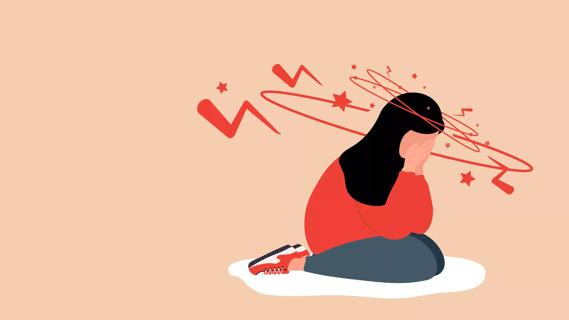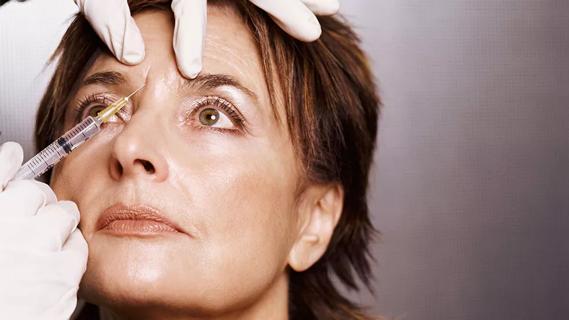Study results don’t conclude hair straighteners cause cancer, but they do raise questions

If you’ve ever gone to a salon to get your hair straightened, you know that it’s an involved process. First, the stylist applies the chemical relaxers. They have to wait just long enough for the right amount of protein bonds to break — you want your hair to be straight, not limp. Then, it’s time to heat treat the hair to seal in the solution.
Advertisement
Cleveland Clinic is a non-profit academic medical center. Advertising on our site helps support our mission. We do not endorse non-Cleveland Clinic products or services. Policy
Throughout this process, your stylist is probably running a fan. That’s because hair-straightening products often contain formaldehyde. When exposed to heat, it releases into a gas. And those fumes are dangerous.
Depending on the type of service you’re getting, having your hair chemically straightened could take anywhere from 30 minutes to several hours. This definitely isn’t the kind of thing that you can DIY in your bathroom. And proper ventilation is necessary to keep both client and stylist safe.
At this point, you may be wondering if it’s a great idea to be putting those chemicals on your hair at all. And you’re not the first to ask that question.
In October of 2022, the Journal of the National Cancer Institute (NJCI) published the latest results of a large-scale observational study called the Sister Study. The results made national news. They showed an association between hair-straightening products and uterine cancer.
We talked to gynecologic oncologist Roberto Vargas, MD, about that study. He explains what motivated it, what it found, what it means and why it matters.
Let’s start with some basics. “Uterine cancer” is an umbrella term. Under that umbrella are endometrial cancers, which are common, and uterine sarcomas, which are rare. There are many different subtypes of endometrial cancers and a few different kinds of uterine sarcomas. They’re all considered estrogen-dependent cancers, meaning they need estrogen — a hormone that we all, regardless of sex, produce — to grow and spread to other parts of the body.
Advertisement
As an oncologist, most of the people Dr. Vargas sees have already been diagnosed. And naturally, they want to know what caused their illness. The biggest contributors, he explains, are conditions that increase overall hormone exposure. That means getting older, having overweight or obesity and using hormone replacement therapy (HRT), among other things.
Right now, you may be further wondering: “How does getting older or carrying more weight increase uterine cancer risk? Doesn’t menopause mean lower (or no) estrogen production?”
Not necessarily.
“We all make estrogen in our fat cells,” Dr. Vargas explains. “If there are more fat cells, there’s going to be more estrogen made peripherally.”
Metabolic changes that happen with menopause increase the likelihood of gaining weight. So, it’s actually possible for your uterine lining cells to see increasing concentrations of estrogen after your period stops, if you naturally gain fat cells. Unless you have had your uterus removed (a hysterectomy), every year you’re alive, the total amount of time your uterus is exposed to estrogen goes up.
According to Dr. Vargas, research on the causes, treatment and prevention of uterine cancers is especially important because these conditions are so common.
In the United States, endometrial cancer is the most common reproductive cancer that women and people assigned female at birth (AFAB) experience. It’s the fourth most common cancer in women and people AFAB overall.
And Dr. Vargas says it’s only getting worse.
“The number of uterine cancer cases is about six times the number of new ovarian cancer diagnoses,” he adds. And the incidence — the number of new cases — keeps going up every year, unlike other cancers. “Uterine cancer will be the third most common type of female cancer within the next 10 years, based on current trends.”
Dr. Vargas says endometrial cancer is also one of only two cancers where survival rates haven’t improved significantly in the past 30 years.
“Anything that we can do to identify risk factors or mechanisms that explain why we’re seeing this uptick in endometrial cancer cases is helpful,” Dr. Vargas continues. “Research is important because we’re trying to reduce the number of new cases that we’re seeing, or at least slow down the increase.”
While uterine cancer is on the rise generally, there’s evidence to suggest the issue is even greater in the Black community.
A 2019 study published by the National Cancer Institute and a 2022 study in JAMA Oncologyboth found that non-Hispanic Black women and people AFAB were more likely to develop an aggressive subtype of uterine cancer — and had poorer survival rates overall.
Advertisement
Remember earlier, when we said that the JNCI study was reporting results from The Sister Study? That’s an important detail.
The Sister Study isn’t a project being undertaken by one lab. It’s a national, multi-agency effort spearheaded by the U.S. National Institute of Environmental Health Sciences. The goal: To learn how genetics and the environment impact breast cancer risk.
To do that, The Sister Study enrolled a lot of people: 50,000 women and people AFAB between the ages of 35 and 74. It’s called The Sister Study because everyone enrolled over the course of the 10-year-long research period is the sister or sibling of a person who developed breast cancer.
In 2019, the Sister Study researchers published an article in Cancer Epidemiology sharing the news that hair dye and chemical straightening products were associated with a higher risk of breast cancer. Two years later, they reported that the same was true with regard to ovarian cancer.
To be clear, neither of these studies concluded that hair products cause cancer. They observed a relationship but couldn’t explain it.
The study authors argued that, based on their findings, hair relaxers need to be researched in greater depth. They suggested some of the chemicals in these products may be carcinogenic, which means they have the potential to cause cancer. It’s also possible that some of the chemicals in hair straighteners are endocrine disruptors, meaning they interfere with hormone production in some way.
Advertisement
The 2022 study on hair straighteners and uterine cancer, then, is the latest in a series of Sister Study observational findings that, taken together, pose important questions about the overall safety of hair-straightening products.
“We need to find out if these chemicals are causing epigenetic changes that affect how certain genes are expressed or not expressed,” Dr. Vargas explains. “These external factors that aren’t hard-coded into the DNA are getting a lot of attention nowadays.”
Once the Sister Study found associations between hair-straightening product use and breast and ovarian cancers, looking at uterine cancer was a logical next step.
And the results were significant. “This study found that women who used hair-straightening products were two times more likely to develop uterine cancer throughout their lifetime,” Dr. Vargas shares.
They came to this conclusion by observing the study participants for nearly 11 years. Of the 33,497 participants, 378 were diagnosed with uterine cancer of some kind during that time.
When they crunched the numbers, the researchers found that 1.64% of women who never used hair straighteners would go on to develop uterine cancer by the age of 70. For frequent users (with frequent defined as getting four or more treatments a year), that risk went up to 4.05%.
Advertisement
Dr. Vargas is quick to clarify that this data doesn’t mean that hair straighteners cause uterine cancer. Like the previous studies, it established an association. The nature of that relationship, though, is unclear.
It’s also important to keep in mind that this study specifically enrolled women and people AFAB whose sisters (and siblings AFAB) had been diagnosed with breast cancer. We don’t know, at this time, if their overall risk of developing hormone-sensitive cancers is higher or lower than folks without that kind of family history.
The Sister Study findings are compelling enough to open the door for research into how hair-straightening products (or, more likely, select chemical components) lead to an increased risk for certain gynecologic cancers … if they do at all.
In other words, it’s an important study. But less because of what it found, and more because it charts a path for future research.
Dr. Vargas says the next reasonable step would be to conduct a study looking at tissue from (1) individuals who were exposed to hair straighteners and got uterine cancer and (2) people who developed uterine cancer but weren’t exposed to hair straighteners. “That may be a way to start unraveling more detailed associations and get to causation,” he says.
He adds that figuring out the difference between those two groups at the genetic and epigenetic level is crucial to understanding how and why these cancers develop as they do.
“My biggest question as an endometrial cancer researcher is trying to identify a mechanism, so we can start to understand how these agents change the individual cells,” Dr. Vargas explains. “I think that’s going to be important for endometrial cancer as a whole, but particularly, for helping us understand environmental factors that contribute to the racial disparities that exist in endometrial cancer.”
It’s understandable for people who’ve had their hair chemically straightened to be a bit nervous reading about these studies. But Dr. Vargas reminds us that, while endometrial cancer is the most common gynecologic cancer, your overall risk of getting it — even when doubled — is still low.
Not convinced? Just look to the study. Based on the number of people the study enrolled (over 30,000) and the number of people who developed uterine cancer (378), the risk is approximately 0.1%. Meanwhile, approximately 1 in 8 women and people AFAB can expect to develop breast cancer at some point in their lives, according to the National Cancer Institute.
The Sister Study’s findings regarding uterine cancer mean that healthcare providers have a decision to make. On the one hand, these are results from an observational study: They raise lots of questions … but they can’t answer any of them.
On the other hand, the findings were dramatic enough to get national attention. They’re also not isolated results. They’re part of a larger body of research that suggests a relationship between hair-straightening products and estrogen-dependent cancers.
So, should doctors be talking to their female and AFAB patients about hair-straightening products, or would that be premature?
“I think, based on the data, that the patient should be made aware that there is an association,” Dr. Vargas says.
But it’s important that the conversation be as nuanced as the study is.
“I can’t tell my patients that hair-straightening products cause cancer because that’s not what the study says,” he reiterates. “And making an assertion that you cannot or should not use hair straighteners — from a medical standpoint — is beyond my scope. The study does suggest that more patients who develop uterine cancer have used hair straighteners in the past, so it would be prudent to consider whether or not we really need to use these products.”
Ultimately, whether you choose to get your hair chemically straightened is a personal choice and there are a lot of different factors to consider, including other gynecologic cancer risk factors you may or may not have. But this much is true for everyone: The more information you have, the more empowered you are to make the decision that’s right for you.
Learn more about our editorial process.
Advertisement

Bleeding is a risk and warrants taking care, but the reward of this lifesaving medication is great

Severe and debilitating headaches can affect the quality of your child’s life

With repeat injections over time, you may be able to slow the development of new wrinkles

Although it can be alarming, it’s normal to experience blood clots during menstruation

Stretch before heading outside, keep proper form and avoid jerking or twisting to throw snow

Type 2 diabetes isn’t inevitable with these dietary changes

Applying a hot or cold compress can help with pain